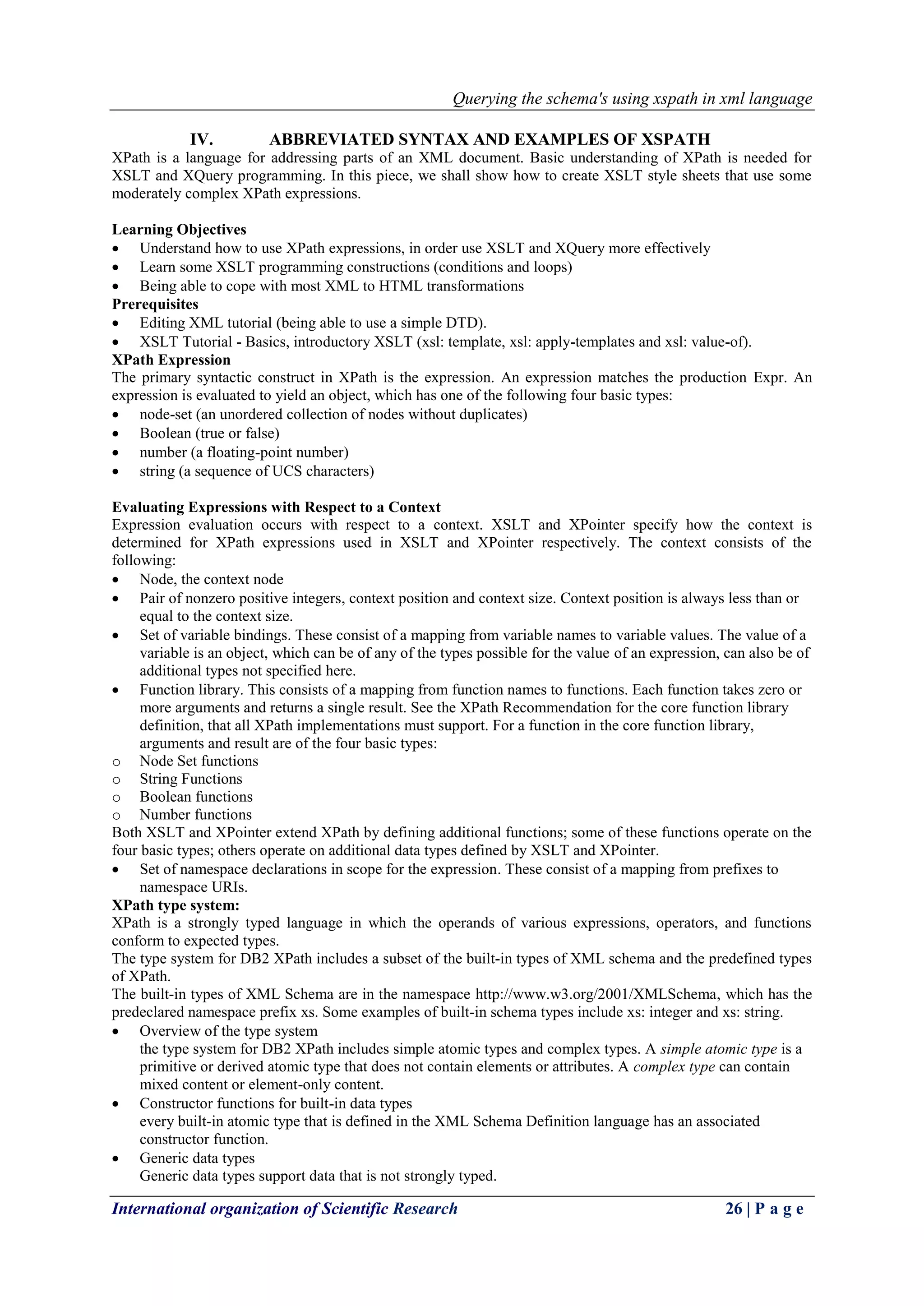This document discusses querying XML schemas using XSPath, a path language for XML schemas. It begins with an abstract stating that XML schemas are used to constrain the structure and content of XML documents, but previous methods of navigating schemas were not easy. XSPath allows navigating and selecting nodes in XML schemas. The document then provides background on XML schemas and XPath, and describes related work on schema exploration and querying. It explains how schemas can be represented and provides an abbreviated syntax and examples of XSPath.

![Querying the schema's using xspath in xml language
International organization of Scientific Research 24 | P a g e
More complex expressions can be constructed by specifying an axis other than the default 'child' axis, a node
test other than a simple name, or predicates, which can be written in square brackets after any step. For example,
the expression
A//B/*[1]
XPath expression applied to an XML file
II. RELATED WORK
XML schema exploration and querying. Many approaches have been proposed by the academic and
industrial communities. Few approaches have been proposed to evaluate XPath expressions on XML schemas.
XML is a meta-markup language developed by the World Wide Web Consortium (W3C) to deal with a number
of the shortcomings of HTML. As more and more functionality was added to HTML to account for the diverse
needs of users of the Web, the language began to grow increasingly complex and unwieldy. The need for a way
to create domain-specific markup languages that did not contain all the cruft of HTML became increasingly
necessary and XML was born.
The main difference between HTML and XML is that whereas in HTML the semantics and syntax of
tags is fixed, in XML the author of the document is free to create tags whose syntax and semantics are specific
to the target application. Also the semantics of a tag is not tied down but is instead dependent on the context of
the application that processes the document. The other significant differences between HTML and XML is that
the XML document must be well-formed.
Although the original purpose of XML was as a way to mark up content, it became clear that XML also
provided a way to describe structured data thus making it important as a data storage and interchange format.
XML provides many advantages as a data format over others, including:
1. Built in support for internationalization due to the fact that it utilizes Unicode.
2. Platform independence (for instance, no need to worry about endianess).
3. Human readable format makes it easier for developers to locate and fix errors than with previous data
storage formats.
4. Extensibility in a manner that allows developers to add extra information to a format without breaking
applications that where based on older versions of the format.
5. Large number of off-the-shelf tools for processing XML documents already exist.
The world of traditional data storage and XML have never been closer together. To better understand
how data storage and retrievel works in an XML world, this paper will first discuss the past, present, and future
of structuring XML documents. Then we will delve into the languages that add the ability to query an XML
document similar to a traditional data store. This will be followed by an exploration of how the most popular](https://image.slidesharecdn.com/e05412327-150507061433-lva1-app6892/75/E05412327-2-2048.jpg)


![Querying the schema's using xspath in xml language
International organization of Scientific Research 27 | P a g e
Data types for untyped data
the xs: untyped and xs: untyped Atomic data types support untyped data.
Xs: string
The data type xs: string represents character strings in XML. Because xs: string is a simple type, it cannot
contain any children.
Numeric data types
the xs: decimal, xs: double, and xs: integer data types support numeric data.
Xs: boolean
the data type xs: boolean supports the mathematical concept of binary-valued logic: true or false.
Date and time data types
the xs: date, xs: time, and xs: date Time data types support date and time data.
Casts between XML schema data types
you can use data type constructor functions to cast a value to a specific data type. Specify the value that you
want to cast and the type to which you want to cast it.
REFERENCES
[1] S. Amer-Yahia, N. Koudas, and D. Srivastava, “Approximate Matching in XML - Tutorial,” Proc. Int’l
Conf. Data Eng., p. 803,2003.
[2] Z. Bellahsene, A. Bonifati, E. Rahm, eds., Schema Matching and Mapping. Springer, 2011.
[3] M. Benedikt and J. Cheney, “Semantics, Types and Effects for XML Updates,” Proc. 12th Int’l Symp.
Database Programming Languages, pp. 1-17, 2009.
[4] M. Benedikt and C. Koch, “XPath Leashed,” ACM Computing Surveys, vol. 41, no. 1, article 3, 2008.
[5] M. Benedikt, W. Fan, and F. Geerts, “XPath Satisfiability in the Presence of DTDs,” J. ACM, vol. 55, no.
2, article 8, 2008.
[6] A. Calı`, G. Gottlob, G. Orsi, and A. Pieris, “Querying UML Class Diagrams,” Proc. Int’l Conf.
Foundations Software Science and Computational Structures, pp. 1-25, 2012.
[7] F. Cavalieri, G. Guerrini, and M. Mesiti, “Navigational Path Expressions on XML Schemas,” Proc. 19th
Int’l Conf. Database and Expert Systems Applications, pp. 718-726, 2008.
[8] F. Cavalieri, G. Guerrini, and M. Mesiti, “Updating XML Schemas and Associated Documents through
EXup,” Proc. IEEE 27th Int’l Conf. Data Eng., pp. 1320-1323, 2011.
[9] C.Y. Chan, W. Fan, and Y. Zeng, “Taming XPath Queries by Minimizing Wildcard Steps,” Proc. 30th
Int’l Conf. Very Large Data Bases, pp. 156-167, 2004.
[10] V.K. Chaudhri and P.D. Karp, “Querying Schema Information,” Proc. CEUR Workshop Intelligent
Access to Heterogeneous Information, vol. 8, pp. 4.1-4.6, 1997.](https://image.slidesharecdn.com/e05412327-150507061433-lva1-app6892/75/E05412327-5-2048.jpg)